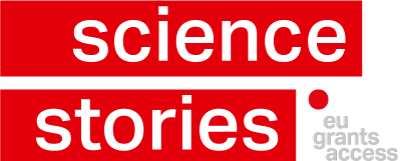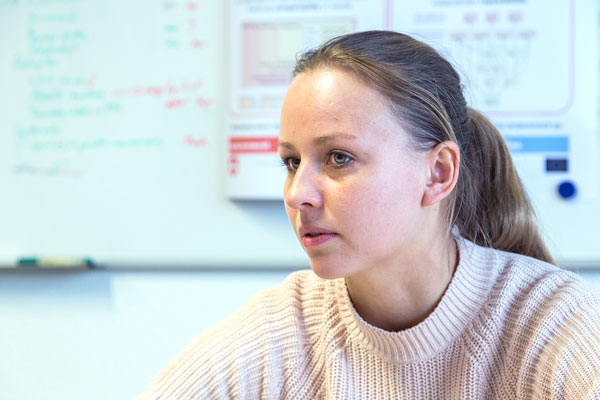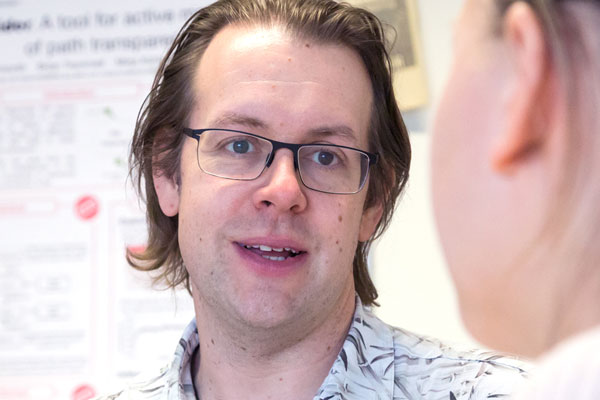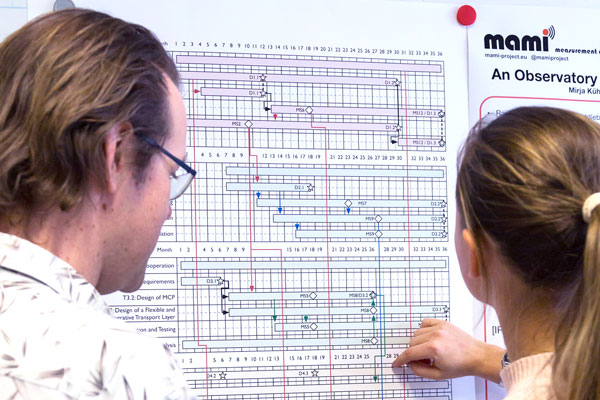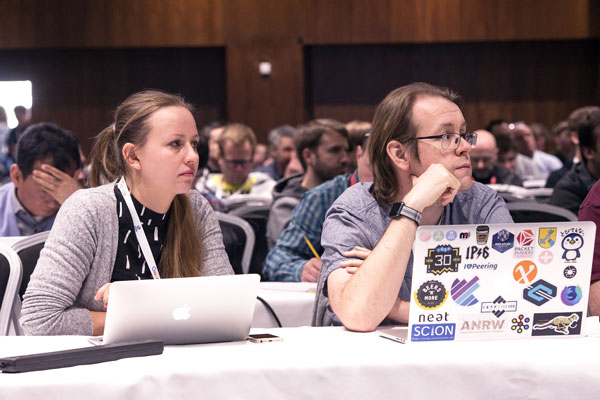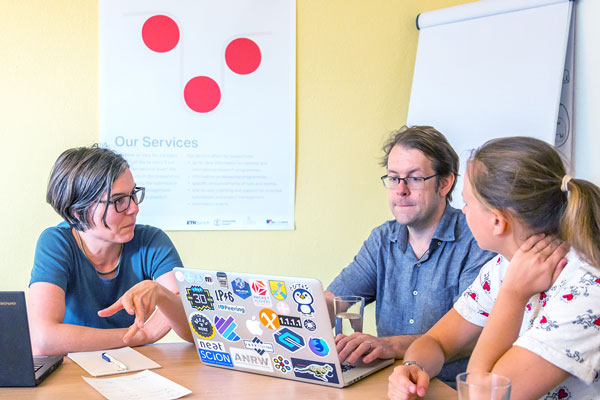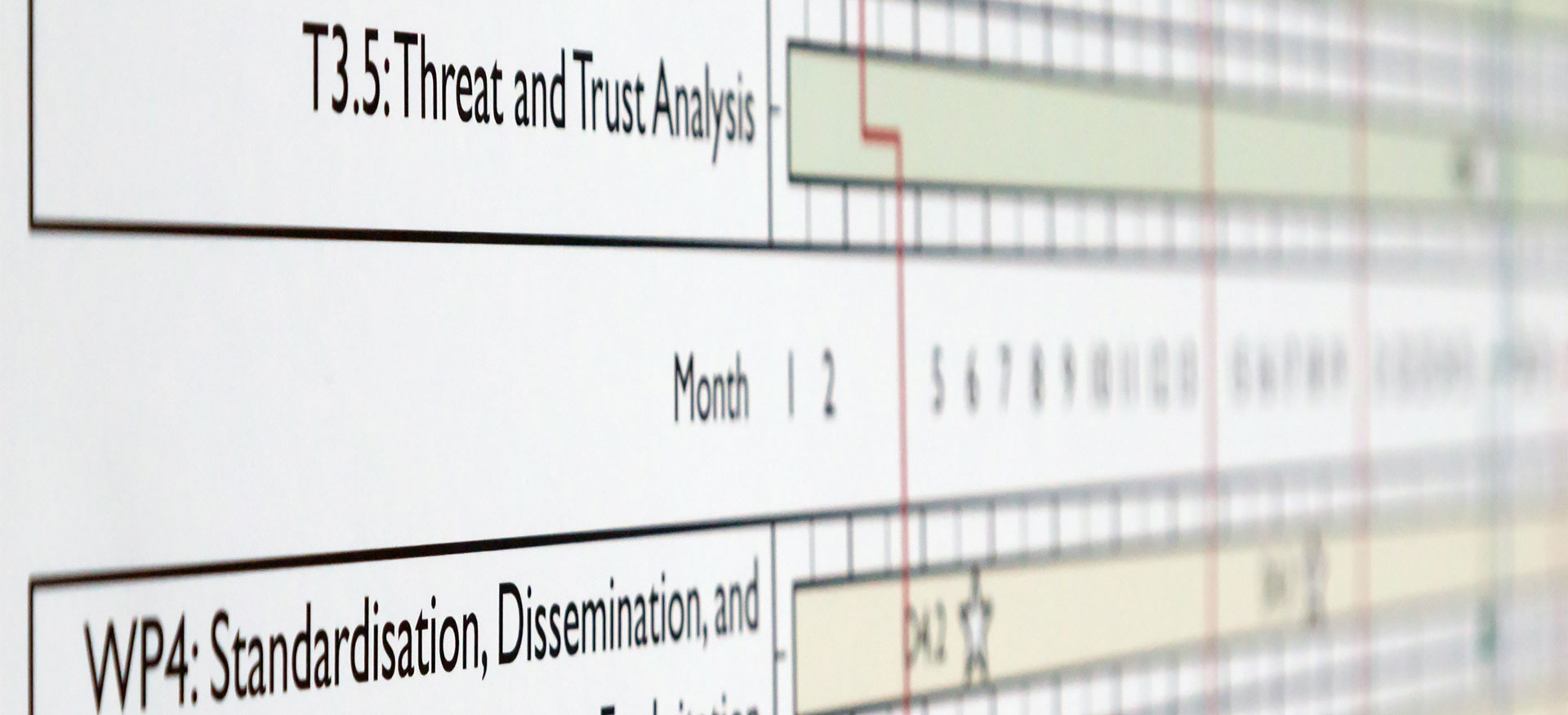
Masters of protocols
How young researchers of ETH Zurich make the Internet work better for everyone. A journey with Mirja Kühlewind and Brian Trammell.
It’s an icy Monday morning in March 2018 in London. While the busy traffic rolls over Edgware Road and commuters pass by, an international meeting on the Internet inside the Hilton Metropole hotel has just been opened. Within the coming five days, more than 1,200 experts – network designers, operators, vendors, researchers and software developers of the Internet Engineering Task Force (IETF) – will meet at the Hilton London Metropole to exchange knowledge, discuss new solutions and work commonly on new standards. The IETF is a large international community of Internet experts who share one common commitment: to make the Internet work better to the benefit of all. Anyone can participate in the IETF provided that the person is willing to contribute his or her technical expertise in an open process to improve the Internet. There is no formal membership or a membership fee. Participants of IETF make their contributions as volunteers, developing jointly relevant high-quality technical documents for the design, use and management of the Internet. While the Internet is a huge complex global network of networks of millions of computers, the IETF is a network of brains from all over the world, dedicated to keep the Internet operating smoothly. Most of the IETF work is done in specialised working groups whose members are cooperating all year round via mailing lists. However, three times a year, the IETF community assembles for a meeting where the results of the working groups are presented and discussed. At the end of a long process based on «rough consensus», the IETF can set a technical solution as a new standard and recommend its deployment, which is subsequently usually well-accepted by the Internet world.
Committed to the Internet community
Among the experts gathering for the IETF session on this Monday morning in London are Mirja Kühlewind and her colleague Brian Trammell, two young researchers and Internet protocol specialists from the Computer Engineering and Networks Laboratory at ETH Zurich. Both have been involved with the IETF for several years and engaged in several working groups and committees. Just before the start of the London meeting, Brian was confirmed for another two-year term as a member of the Internet Architecture Board (IAB), which is part of the IETF. And Mirja has just started her second term as an area director of the Transport Area of the IETF, which comprises several working groups dealing with transport and forwarding problems. Mirja happened to join the IETF when she was a PhD student because of a project she was running with a colleague at that time. As she participated very actively in the discussions of the working groups, her colleagues in the IETF motivated her to become first working group chair and then finally one of the directors of the Transport Area in 2016. «My role as an area director is mainly to coordinate and keep the process running properly,» she explains when we meet for a coffee in the hotel lobby between two morning sessions. «I read all documents from every working group in all areas and add my comments before they finally get published. Our aim in the Transport Area is to adapt existing transport protocols or to develop new ones that will be published eventually as so-called Requests for Comments (RFCs). These are the standard documents produced by the IETF that are needed for large-scale deployment in the Internet. But this is a long way to go, as not only technology but also politics play a role. You have to convince the community and win the support of the key players of the Internet.» Mirja spends a great deal of her time on work she is doing in the IETF and during the six days of the IETF meeting in London she is facing a tough time, chairing sessions, participating in discussions and meeting people. But as her research topic at ETH Zurich matches perfectly with the problems she is dealing with as an area director, her engagement is beneficial for both her research at ETH Zurich and the IETF.
Privacy versus functionality – conflicting demands
Since her time as PhD student, Mirja Kühlewind has been dealing with the design of transport protocols, congestion control and the measurement of the Internet. We just take it for granted that emails reach their destination precisely, websites will open in no time and documents, pictures and videos can be downloaded or streamed whenever and wherever. But to make these tremendous communication services of the Internet work, a sophisticated technology of «protocols» is needed. They ensure that the data packets are transported safely through the network in the most optimal way and reach their destinations reliably. TCP (Transmission Control Protocol, which manages transmissions between computers connected to the Internet) and IP (Internet Protocol, which makes sure that packets get across the network) are two of the most common standardised protocols applied by almost all systems. But the Internet is constantly changing due to new technologies, services, needs and demands. Consequently, the Internet protocols also have to be adapted to keep the Internet operating smoothly. Apart from new needs and technologies, there is also another development that challenges the hitch-free functioning of the Internet: The growing desire of the users to protect their privacy by encrypting their data as it crosses the network.
«The IETF is a network of brains
from all over the world,
dedicated to keep the Internet
operating smoothly.»
While increasing security and privacy for the users is an important goal for many people working in the IETF, it also means that in some cases less information is available to the network that has previously been used to optimise the packet flow through it. As a result, data packets might get unintentionally stuck, changed or sorted out somewhere on their way through the Internet; they might even slow down the system as a whole. It is like ship containers being packed into special boxes, changing their shapes, preventing anyone from detecting the content of the containers and then provide the boxes with encrypted addresses. Of course, this would cause great confusion along the entire global transport chain.
As a researcher and area director of IETF, Mirja is aware of the conflicting interests between the demands for privacy and the smooth Internet traffic management. «I fully agree that privacy is a key priority in the Internet,» she says, «but the network needs some information about the data packets it transports in order to handle them safely and efficiently. If we start to encrypt everything, this information is lacking. Therefore, about four years ago, inspired by the discussion within the IETF, Brian and I started thinking about the information the network absolutely needs in order to work properly and how we can provide this information only, not more and not less.» To address this problem in depth, Mirja and Brian took the chance when there was a call from the European Commission in 2015 for collaborative projects within the Horizon 2020 programme. They wrote a proposal, arranged a consortium of seven partner institutions (four universities, two companies, one research laboratory), convinced the Commission and received the funds for their MAMI project (Measurement and Architecture for a Middleboxed Internet), which started in January 2016.
The MAMI project
By the MAMI project, Mirja, Brian and their partners of the consortium try to overcome three conflicting trends in the Internet: The expanding deployment of encryption to protect end users’ privacy, the increasing use of in-network functionality provided by middleboxes and the expansion of new applications like interactive videos demanding for new protocols which will then be impaired with the middleboxes. The aim of the project is to restore the balance between encryption, innovation in protocols and functionalities provided by middleboxes in a cooperative way. Hence, the key target addressed by the MAMI project are the so called «middleboxes» – devices that transform, inspect, filter or otherwise manipulate traffic for other purposes than just forwarding packets. Middleboxes can be firewalls, network address translators, etc.
While we order another coffee from the waiter in the hotel lobby, Mirja explains their approach: «Originally, the only purpose of a network router was to look at the packet in order to see where it should go and then forward it or, if necessary, drop it. But there are so many additional services in the network today, especially in mobile networks, where middleboxes optimise a great deal. The problem is that they have so many functions, nobody knows what they are doing. So, your transmission might suffer because now it encrypts something that wasn’t encrypted before and has been used as input for one of the middlebox functions on the path. In order to overcome this problem, we developed a middlebox cooperation protocol which can be used together with the Transport Control Protocol (TCP) as well as new transport protocols that are currently standardised such as Quick UDP Internet Connections (QUIC), which will then provide the middleboxes with the necessary information but, at the same time, secure privacy of all other data.» For the development of this solution, Mirja and her team have carried out extensive measurements of the Internet within the past months. Tests showed that their middlebox cooperation protocol works and could be implemented. «The goal of the project has been to get this new protocol defined as standard by the IETF and recommend its deployment,» Mirja explains.
«The Internet is so important
to freedom of society.
As I have the technical skill
to improve the Internet
it makes sense to me to do it.»
But so far, she, Brian and the MAMI team have not yet succeeded to convince the IETF community. So, they currently work on integrating the developed mechanisms directly into new protocols, such as QUIC, instead of having a separate protocol that could be used in combination with all future transport protocols the same way. Finally, the MAMI project will end quite successfully in a few months. Besides a new protocol that offers a technical solution to a burning problem of the Internet, the team also gained much knowledge and experience through their measurements, which will be available to the research community and contribute to a better understanding of the Internet.
Coordinating a collaborative EU project
When Mirja and Brian launched the MAMI project in 2014, the question arose: Who will coordinate it? «Neither Brian nor I intended to coordinate the project, because at that time it was not clear whether Switzerland would still participate in the Horizon 2020 programme,» Mirja declares. «But as nobody else volunteered, I said I’d figure it out and do it. It is the first time I coordinate an EU project.» One good reason Mirja finally agreed to take over the coordination was the support offered by Katharina Eggenberger of the EU GrantsAccess office. Katharina is an experienced research manager of this service institution, provided jointly by ETH Zurich and the University of Zurich, knowing the rules and regulations for EU grants and the formal management procedures for EU projects very well. So right from submission up to now she has been accompanying the MAMI team as an administrative manager and coach. «Katharina has dealt with all the contract issues with the legal people of the partners. She is also preparing the management and financial reports we have to submit and she helps us in every way to manage the project. I only have to add the technical part to the reports and can focus entirely on the scientific and technical aspects of the project. It’s great,» Mirja rejoices. Before we have to end the coffee break as the next session starts, I ask Mirja about the reasons behind her dedication to improve the Internet: «On the wall in my office at ETH Zurich, there is a world map showing the freedom of press. I think the Internet is so important to society, for the freedom of speech, the freedom of press and for an open world. And as I have the skill to work in the technical area to improve the Internet it makes sense to me to do it. And beyond all that – it’s fun,» she answers and rushes to the next IETF session on this cold Monday morning at Hilton London Metropole.
Interview with Mirja Kühlewind
Mirja Kühlewind
Mirja Kühlewind has been a postdoctoral researcher at the Networked Systems Group (NSG) of the Computer Engineering and Networks Laboratory at ETH Zurich since 2015. From 2003 to 2008, she studied at the Friedrich-Alexander-Universität (FAU) of Erlangen-Nürnberg, where she received her Diploma degree in Information and Communication Technology. In 2015, she acquired her PhD from the University of Stuttgart, where she worked as a researcher at the Institute of Communication Networks and Computer Engineering (IKR). Mirja Kühlewind is foremost dealing with the design of transport protocols focusing on congestion control as well as Internet measurements investigating the deployability of new protocols. She is the project coordinator of the EU Horizon 2020 MAMI project that started in January 2016. Since March 2016, she has been serving as an area director of the Transport Area in the Internet Engineering Task Force (IETF).
Brian Trammell
Brian Trammell has been a senior researcher at the Networked Systems Group (NSG) of the Computer Engineering and Networks Laboratory at ETH Zurich since 2010. His main research fields are Internet measurement and the evolution of the Internet architecture. Prior to his work at ETH Zurich, Brian Trammell worked on privacy preservation and transparency in network monitoring tools at Hitachi Europe, led the engineering team at CERT Network Situational Awareness at Carnegie Mellon University's Software Engineering Institute, and worked as a software engineer in various short-lived start-ups in Pittsburgh and Atlanta during the dotcom bust. He received his degree in Computer Science from the Georgia Institute of Technology in 2000. Brian Trammell has been a member of the Internet Architecture Board since March 2014.
Project funded by Horizon 2020
«MAMI – Measurement and Architecture for a Middleboxed Internet»; European collaborative Research and Innovation Action
Duration: 2016-2018
Coordinator: ETH Zurich, Switzerland
Partners: 7 partners from 5 different countries
Financial contribution from H2020: 1,629,125 €
(928,000 € for ETH Zurich)
